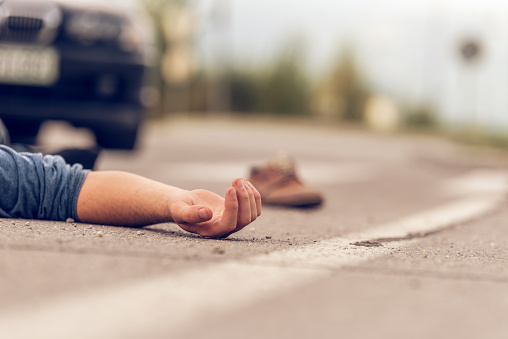
Charges are pending against a 36-year-old man who was allegedly speeding when he ran a red light and pushed another vehicle into a 65-year-old man.
According to police, a 2020 Cadillac SUV crashed into a Hyundai Sonata at West 1st Street and Avenue P. The force of the impact propelled the Sonata into a Two Bridges resident. Emergency responders rushed the injured man to a nearby hospital, where he was declared dead.
No other details were available.
Civil and Criminal Court
Other than alcohol-related wrecks, authorities rarely file criminal charges in car crash cases, even if the tortfeasor (negligent driver) clearly broke the law. Typically, police officers don’t want to wade into what they consider civil disputes. So, they only press charges in extreme cases. Blowing through a red light and killing a 65-year-old man apparently counts as extreme, as far as the NYPD is concerned.
Most likely, authorities pressed charges because the at-fault driver ran a red light and was speeding. If the facts only involved one or the other, a criminal case would probably not be forthcoming.
In dual forum cases, the burden of proof is the biggest difference. In the 1990s, disgraced football star O.J. Simpson faced murder charges in criminal and civil court. Although they heard basically the same evidence, a criminal jury let Simpson walk and a civil jury ruled against him. That’s because the burden of proof is different in civil and criminal court.
Prosecutors must establish guilt beyond a reasonable doubt in criminal court. However, a New York personal injury attorney must only establish negligence, or a lack of care, by a preponderance of the evidence, or more likely than not, in civil court.
The purpose of these two proceedings is different as well. Criminal courts punish offenders when they break laws. The punishment is usually court supervision and/or a fine. Civil courts compensate victims and survivors. This compensation usually includes money for economic losses, such as medical bills, and noneconomic losses, such as pain and suffering.
At least one thing is the same. Fewer than 10 percent of civil and criminal cases go to trial. Plea bargains usually resolve criminal cases, and out-of-court settlements usually resolve civil cases. The resolution time frame is usually different. Many criminal cases settle almost immediately, especially if the defendant is in jail. However, the civil court settlement process usually takes at least several months.
Speed and Pedestrian Accidents
Statistically, the extreme speed of the above collision unfortunately sealed the pedestrian’s fate. Velocity multiplies the force in a collision between two objects, such as a vehicle and a pedestrian, according to Newton’s Second Law of Motion.
The effect is even more dramatic in pedestrian accidents. At impact speeds above 25mph, the pedestrian death rate is about 10 percent. At impact speeds above 55mph, the fatality rate catapults to 90 percent. Additionally, since the mid 2010s, the overall pedestrian fatality total has increased significantly.
In response to the overall increase, leaders in New York City and other locales unveiled aggressive “Vision Zero” plans which promised to end pedestrian fatalities by around 2030. However, these promises are mostly unfulfilled. Part of the problem is unexpected opposition to pedestrian safety measures. Generally, motorists oppose traffic calming measures, like lower speed limits and raised crosswalks that resemble wide speed bumps.
When politicians fail to protect people, a New York personal injury attorney stands up for victims. Civil claims don’t just compensate victims. They also bring attention to the problem and hold negligent drivers responsible for the mistakes they make.
Liability Issues
Most pedestrian accidents happen outside marked crosswalks. Most people think that the pedestrian victims have no legal options in these situations. Most people are wrong.
Before we go further on this point, let’s delve a little deeper into the purpose of a civil lawsuit. The crash in the above story was obviously unintentional. We all make mistakes, and not just the speeding driver in the above story. However, we should all accept responsibility for the mistakes we make.
If Tom backs out of his driveway too quickly and runs over his neighbor’s mailbox, he should pay compensation (replace the mailbox). Likewise, if Tom hits his neighbor on the street, Tom should pay compensation as outlined above. There’s a big difference between Tom’s neighbor and a mailbox.
In a few cases, the negligence per se shortcut could apply in pedestrian accident claims. The above story is one of these few examples. When tortfeasors violate safety laws and cause injuries, they could be responsible for damages as a matter of law. These safety laws establish the standard of care. Breaking one of them violates the standard of care, meaning damages are available.
However, police officers rarely issue citations, as discussed above. So, a New York personal injury attorney must use the ordinary negligence doctrine to obtain compensation for victims. There are four basic elements in a negligence case:
The emergency doctrine often comes up in non-crosswalk pedestrian accident claims. Drivers aren’t responsible for damages if they reasonably react to sudden emergencies. Usually, a “sudden emergency” is a lightning strike or another completely unanticipated event. Everyday hazards, like jaywalking pedestrians, don’t count.Injury victims are entitled to substantial compensation. For a free consultation with an experienced personal injury lawyer in New York, contact the Pianko Law Group, PLLC. You have a limited amount of time to act.